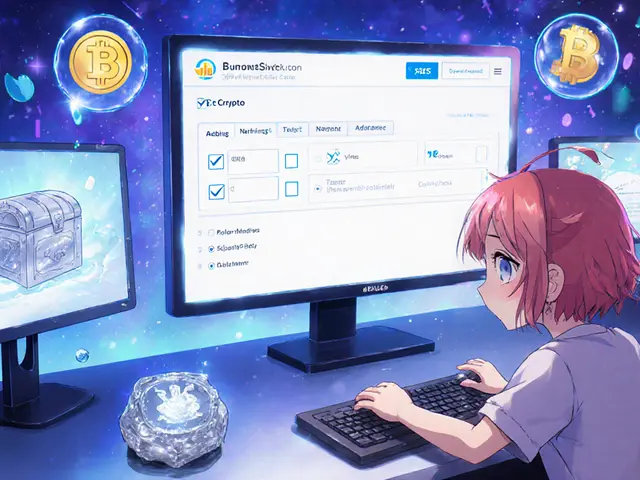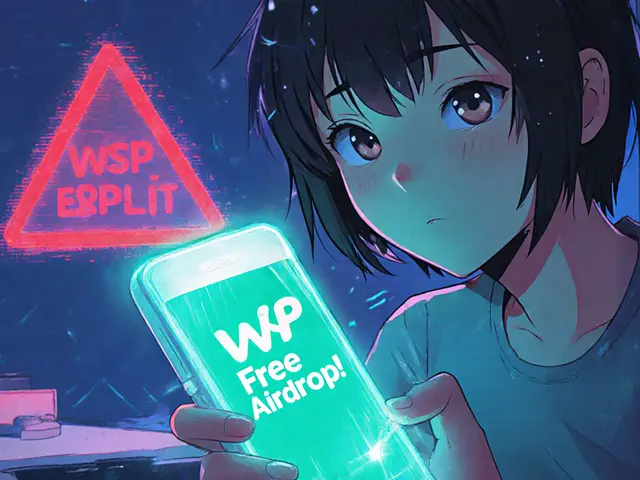Tegro.Finance Slippage Calculator
Estimate Your Trade Impact
Tegro.Finance has low liquidity (TVL: $150k, Volume: $5.8k). High slippage is likely for larger trades.
Trade Impact Analysis
For reference: A 5% slippage on a $1,000 trade costs you $50 in reduced value.
Tegro.Finance is a decentralized exchange (DEX) built on The Open Network (TON) blockchain. Launched in 2022, it combines an Automated Market Maker (AMM) model with an NFT marketplace called Libermall Marketplace. The platform’s native utility token, TGR, powers liquidity incentives, staking rewards and payment functions through the linked Tegro Money wallet. If you’re hunting for a quick take on whether this niche DEX is worth your time, keep reading - we’ll break down how it works, what you get, and the red flags you should watch.
What makes Tegro.Finance different?
Most DEXs you’ve heard of - Uniswap, PancakeSwap, Raydium - serve massive ecosystems with billions of dollars in daily volume. Tegro.Finance, by contrast, focuses exclusively on “newborn” projects launching on the TON chain. Its AMM engine automatically creates pools for any token that meets a minimal liquidity threshold, while the NFT side lets creators list digital collectibles without leaving the platform.
The Tegro.Finance review often highlights two promises: ultra‑low fees and a friendly launch‑pad for early‑stage TON tokens. The fee claim comes from the fact that the protocol takes a flat 0.25% on swaps, slightly under the 0.30% standard you see on Uniswap or SushiSwap. However, the real cost you’ll feel is slippage, because the exchange’s total 24‑hour volume sits under $6,000 (May 2024 data), making large trades practically impossible without moving the market.
Key features at a glance
- AMM trading: No order book, swaps happen against liquidity pools.
- Integrated NFT marketplace: Directly buy, sell or mint NFTs via Libermall.
- Zero‑KYC onboarding: Connect any TON‑compatible wallet and start trading.
- TGR token utility: Staking, farming, governance, and payment gateway for Tegro Money.
- Referral program: Two‑tier binary rewards that pay out in TGR.
- Low fee claim: 0.25% swap fee (officially listed on the homepage).
How to get started - step‑by‑step
- Install a TON‑compatible wallet. Popular choices include Tonkeeper and TON Wallet. Both are browser extensions or mobile apps.
- Fund the wallet with some TON or a supported token (e.g., USDT‑TON). You can buy TON on larger exchanges like Binance and then transfer to your wallet.
- Visit tegro.finance and click “Connect Wallet”. The site will prompt your extension to approve the connection.
- Choose the pool you want to trade. If you’re swapping TON for a new token, look for the pool name (e.g., TON/TGR). The interface shows the pool’s size and estimated price impact.
- Enter the amount, review the slippage tolerance (set it low, e.g., 0.5%, to avoid surprise losses), and confirm the transaction in your wallet.
- If you hold TGR, consider staking in the “Launch Pool” to earn extra rewards. The staking page displays APY (currently around 18% annualized) and the lock‑up period.
That’s it - no email, no ID upload, just a wallet signature.

Liquidity and volume - the numbers that matter
Liquidity is the lifeblood of any AMM. As of May 2024, the total value locked (TVL) in Tegro.Finance’s pools hovered around $150,000, while daily swap volume was $5,800. By October 2025, CoinMarketCap still lists the exchange as “Untracked”, meaning the data set does not meet its minimum thresholds for regular reporting. For comparison, Uniswap processes over $1.5 billion daily, PancakeSwap $850 million, and even niche TON DEX STON.fi moves roughly $15 million per day.
What does this mean for you? Small liquidity leads to high price impact. If you try to swap $1,000 of TGR, you could see a 10-15% price change, wiping out the theoretical profit from any arbitrage or farming strategy.
Risk checklist - should you trust Tegro.Finance?
- Liquidity scarcity: Low TVL and volume increase slippage and the chance of impermanent loss for LPs.
- Token price decline: TGR fell 92.8% from its January 2023 ATH of $0.2202 to $0.0159 in May 2024.
- Untracked status: Absence from major tracking sites limits transparency.
- Limited community support: No official Telegram, Discord or active Reddit threads discovered in public searches.
- Regulatory gray area: While Tegro LLC is a registered company, the jurisdiction and AML policies are not publicly disclosed.
- Potential reward upside: Early‑stage TON projects can explode, and TGR staking offers up to 18% APY.
If you’re comfortable with high risk and want exposure to ultra‑niche TON startups, a tiny allocation (e.g., under $200) could be acceptable. For anyone seeking reliable liquidity, more established DEXs make more sense.
How Tegro.Finance stacks up against the big players
| Feature | Tegro.Finance | Uniswap (Ethereum) | PancakeSwap (BSC) | Raydium (Solana) |
|---|---|---|---|---|
| Primary blockchain | TON | Ethereum | Binance Smart Chain | Solana |
| Swap fee | 0.25% | 0.30% | 0.25% | 0.25% |
| Daily volume (USD) | ~$5,800 | $1.5 B+ | $850 M | $120 M |
| TVL (USD) | ~$150,000 | $9 B+ | $3 B | $500 M |
| KYC required | No | No (optional) | No | No |
| NFT marketplace | Yes (Libermall) | Yes (OpenSea integration) | Yes (Marketplace) | Yes (Metaplex) |
| Community size (Telegram members) | ~200 (unverified) | ~650k | ~350k | ~200k |
The table makes it clear: Tegro.Finance excels only in niche focus and fee‑slight advantage. In every other metric - volume, TVL, community support - it trails far behind.

Future outlook - will Tegro.Finance survive?
Analysts note a consolidation trend in the DEX market: the top five platforms capture roughly 79% of total volume (DappRadar, Oct 2025). Niche players need either a strong community or a unique value proposition to stay relevant. Tegro.Finance’s claim of being the “best AMM+NFT DEX for newborn TON projects” is still unproven, given the stagnant volume and lack of visible product upgrades since the 2023 roadmap announcement.
Potential growth paths include:
- Partnerships with TON launchpads: If STON.fi or other TON hubs direct early tokens to Tegro.Finance, liquidity could improve.
- Enhanced incentive programs: Raising APY or adding cross‑chain bridges would attract liquidity providers.
- Regulatory clarity: Formal KYC/AML policies might build institutional trust, but could also deter the no‑KYC crowd.
Until such moves materialize, the platform remains a high‑risk, low‑reward corner of the market.
Bottom line - should you use Tegro.Finance?
If you’re a crypto hobbyist looking to experiment with TON‑based newborn tokens and you don’t mind paying higher slippage, a small test trade on Tegro.Finance can be a learning experience. For anyone needing reliable liquidity, low‑cost swaps, or a solid community, stick with Uniswap, PancakeSwap, or Raydium.
Quick cheat‑sheet
- Best for: Exploring new TON projects, NFT drops on Libermall.
- Avoid if: You need large trade sizes, low slippage, or proven liquidity.
- Key metric to watch: TVL under $200k and daily volume under $10k.
- How to start: Install Tonkeeper, fund with TON, connect to tegro.finance, swap.
- Risk tip: Never allocate more than 5% of your crypto portfolio to TGR or related pools.
Is Tegro.Finance a scam?
No official scam reports list Tegro.Finance, and its parent company Tegro LLC is a registered entity. However, the exchange’s low liquidity and untracked status mean you should treat it as a high‑risk platform rather than a guaranteed safe investment.
Do I need to verify my identity?
No. Tegro.Finance operates with a zero‑KYC model - you only need a TON‑compatible wallet to start swapping.
What fees will I pay?
The protocol charges a flat 0.25% swap fee. Keep in mind that slippage can add hidden costs if the pool is shallow.
How can I earn rewards on Tegro.Finance?
By staking TGR in the launch/farming pools you earn APY (around 18% at the time of writing) and by participating in the binary referral program, which pays out additional TGR.
Is there a roadmap for future improvements?
The last public roadmap (2023) promised better affiliate terms and staking upgrades, but no concrete updates have appeared in 2024‑2025, so progress remains uncertain.







Comments
Jessica Pence
October 20, 2025 AT 09:05 AMI think the biggest drawback of Tegro.Finance is the lack of liquidity – you end up slippin' a lot when you try to move even modest amounts. The 0.25% fee looks good on paper, but the real cost shows up in price impact. Also, the TVL is barely $150k which means any big trade will move the market dramatically. For newbies it might be a fun playground, but don’t expect stable returns. Keep your exposure tiny and treat it as an experiment.
johnny garcia
October 23, 2025 AT 20:25 PMOne must contemplate the epistemic ramifications of engaging with a DEX of such marginal depth; the ontological risk is palpable. Yet, the allure of a 0.25% fee within a zero‑KYC environment presents a paradox worth noting. Thus, I posit that discerning participants may allocate a token‑size sliver to assess systemic resilience. 🌐📈
Ryan Comers
October 27, 2025 AT 07:45 AMEveryone keeps hyping these tiny niche DEXs like they're the next big thing, but the reality is they’re just a playground for speculators. 😤 If you’re looking for genuine liquidity, look elsewhere – this platform is a mirage. The national crypto scene deserves better than these low‑volume experiments.
Prerna Sahrawat
October 30, 2025 AT 19:05 PMIn the grand tapestry of decentralized finance, Tegro.Finance emerges as a curiosity, an ode to the avant‑garde aspirations of the TON ecosystem. Its conception rests upon the romantic notion of nurturing embryonic projects, bestowing upon them a sanctuary where liquidity, albeit scarce, is meticulously curated. Yet the stark metrics-sub‑$200k TVL and a daily volume that scarcely dents the $10k threshold-paint a portrait of fragility that cannot be ignored. One might argue that the platform's ambition is laudable, but ambition without a robust substrate is tantamount to building castles upon sand. The nuance lies in the juxtaposition of its ultra‑low fee structure against the inexorable reality of slippage, which, in shallow pools, becomes a leviathan devouring any semblance of profit. Moreover, the absence of transparent governance and the nebulous jurisdiction of Tegro LLC cast shadows upon its regulatory posture, prompting a cautious appraisal. While the NFT marketplace integration offers a veneer of diversification, it merely scratches the surface of what a holistic DEX experience demands. Investors, therefore, must weigh the potential upside of pioneering exposure to nascent TON tokens against the palpable hazards of liquidity scarcity and market opacity. In essence, Tegro.Finance stands as a microcosm of the broader challenges confronting niche decentralized exchanges: a delicate balance between innovation and viability, aspiration and execution, promise and peril.
Erik Shear
November 3, 2025 AT 06:25 AMHonestly i think the long post is right we need to be careful it’s risky but it can be fun
Tom Glynn
November 6, 2025 AT 17:45 PMHey folks, if you’re diving into Tegro, remember it’s a learning curve. Start small, stake TGR if you want that 18% APY, and keep an eye on the slippage. You’ll get the hang of it faster than you think! 😊
Johanna Hegewald
November 10, 2025 AT 05:05 AMGood tip, Tom. Just keep the amount tiny and you’ll avoid the big price swings. Easy enough for most beginners.
Benjamin Debrick
November 13, 2025 AT 16:25 PMIndeed, the platform, while ostensibly promising, manifests a plethora of structural deficiencies; its limited community, negligible TVL, and untracked status coalesce into a veritable quagmire of uncertainty, thereby necessitating a judicious appraisal prior to capital deployment; consequently, prospective participants ought to calibrate expectations accordingly, lest they succumb to the illusion of facile returns.
Anna Kammerer
November 17, 2025 AT 03:45 AMOh, look at that-another “sure thing” with a side of sarcasm. Sure, if you enjoy watching your funds evaporate into thin air, go ahead. Otherwise, maybe stick to the big guys.
Mike GLENN
November 20, 2025 AT 15:05 PMReading through the review, I’m struck by how the narrative captures the bittersweet reality of emerging DeFi platforms. On one hand, there’s the excitement of being an early adopter, the thrill of staking and possibly reaping a generous APY. On the other hand, the visceral discomfort of watching a modest trade get shredded by slippage is hard to ignore. I’ve seen similar patterns in other niche exchanges: initial hype, followed by a sobering adjustment as liquidity constraints surface. The key takeaway for me is to treat this as an exploratory sandbox rather than a serious investment vehicle. Allocate only a fraction of your portfolio-perhaps under five percent-as the review wisely suggests, and monitor the community signals closely. If the platform gains traction through partnerships or incentive overhauls, then a reassessment may be warranted. Until then, caution remains the prudent path.
BRIAN NDUNG'U
November 24, 2025 AT 02:25 AMExcellent analysis, Mike. Your balanced approach exemplifies the prudent mindset required for navigating such speculative waters. Stay motivated and keep learning!
Donnie Bolena
November 27, 2025 AT 13:45 PMLet’s stay positive! Even a tiny slice of the market can be a stepping stone; who knows, the next big TON project could launch here! Keep your eyes open, stay optimistic, and enjoy the ride!!!
Elizabeth Chatwood
December 1, 2025 AT 01:05 AMLooks risky.
Tom Grimes
December 4, 2025 AT 12:25 PMI feel like I should say something, you know? This whole conversation about liquidity keeps pulling at my thoughts, and I can’t help but wonder how many people are actually feeling the same unease. The platform’s promises sound nice, but the numbers are screaming louder than any marketing copy. It’s almost like we’re all dancing around a truth we’re scared to face.